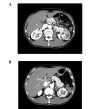Successful treatment of erythropoietin-producing advanced renal cell carcinoma after targeted therapy using sunitinib: Case report and review of the literature
- PMID: 24649132
- PMCID: PMC3956246
- DOI: 10.3892/mco.2012.5
Successful treatment of erythropoietin-producing advanced renal cell carcinoma after targeted therapy using sunitinib: Case report and review of the literature
Abstract
In general, only ≤5% of patients with renal cell carcinoma (RCC) develop paraneoplastic erythropoietin (EPO) overproduction-induced polycythemia. However, a number of reports on EPO-producing RCC are available. The present study aimed to report the first case of a patient demonstrating a therapeutic effect on EPO-producing advanced RCC, subsequent to targeted pre-surgical sunitinib therapy, with a review of the literature. The patient involved was a 62-year-old male who presented with a malformation of the left scrotum. Examination revealed a tumor of 73 mm in diameter along with lymph node metastasis. The histological examination indicated a clear cell RCC containing viable cells as well as hemorrhage and necrosis. EPO in cancer cells was confirmed by immunohistochemistry. Subsequently, a case of EPO-producing RCC with polycythemia was diagnosed. The EPO-producing RCC was successfully treated following targeted presurgical therapy with sunitinib.
Keywords: erythropoietin; polycythemia; renal cell carcinoma; sunitinib.
Figures





Similar articles
-
Erythropoietin gene expression in renal carcinoma is considerably more frequent than paraneoplastic polycythemia.Int J Cancer. 2007 Dec 1;121(11):2434-42. doi: 10.1002/ijc.22961. Int J Cancer. 2007. PMID: 17640059
-
Unintentional Dual Benefit: Improvement in Secondary Polycythemia in a Patient Receiving Chemotherapy for Metastatic Clear Cell Renal Cell Carcinoma.Eur J Case Rep Intern Med. 2022 Feb 18;9(2):003125. doi: 10.12890/2022_003125. eCollection 2022. Eur J Case Rep Intern Med. 2022. PMID: 35265544 Free PMC article.
-
Erythropoietin production in renal cell carcinoma and renal cysts in autosomal dominant polycystic kidney disease in a chronic dialysis patient with polycythemia: A case report.Oncol Lett. 2014 Nov;8(5):2032-2036. doi: 10.3892/ol.2014.2469. Epub 2014 Aug 21. Oncol Lett. 2014. PMID: 25295086 Free PMC article.
-
[A case of erythropoietin-producing renal cell carcinoma with polycythemia].Hinyokika Kiyo. 2002 Sep;48(9):531-4. Hinyokika Kiyo. 2002. PMID: 12402477 Review. Japanese.
-
Functional significance of erythropoietin in renal cell carcinoma.BMC Cancer. 2013 Jan 10;13:14. doi: 10.1186/1471-2407-13-14. BMC Cancer. 2013. PMID: 23305401 Free PMC article. Review.
Cited by
-
Erythrocytosis caused by giant chromophobe renal cell carcinoma: a case report indicating a 9-year misdiagnosis of polycythemia vera.Chin J Cancer. 2017 Sep 6;36(1):72. doi: 10.1186/s40880-017-0238-z. Chin J Cancer. 2017. PMID: 28877745 Free PMC article.
-
Case: Secondary polycythemia due to pazopanib in patients with metastatic renal cell carcinoma.Can Urol Assoc J. 2017 Nov;11(11):E449-E450. doi: 10.5489/cuaj.4519. Can Urol Assoc J. 2017. PMID: 29072563 Free PMC article. No abstract available.
References
-
- Chow WH, Devesa SS, Warren JL, Fraumeni JF., Jr Rising incidence of renal cell carcinoma in the United States. JAMA. 1999;281:1628–1638. - PubMed
-
- Marumo K, Kanayama H, Miyao N, Nakazawa H, Ozono S, Horie S, Nagamori S, Igarashi T, Hasegawa M, Kimura G, Nakao M, Nakamoto T, Naito S. Prevalence of renal cell carcinoma: a nation-wide survey in Japan, 2002. Int J Urol. 2007;14:479–482. - PubMed
-
- Da Silva JL, Lacombe C, Bruneval P, Casadevall N, Leporrier M, Camilleri JP, Bariety J, Tambourin P, Varet B. Tumor cells are the site of erythropoietin synthesis in human renal cancers associated with polycythemia. Blood. 1990;75:577–582. - PubMed
-
- Westenfelder C, Baranowski RL. Erythropoietin stimulates proliferation of human renal carcinoma cells. Kidney Int. 2000;58:647–657. - PubMed
-
- Muta H, Funakoshi A, Baba T, Uike N, Wakasugi H, Kozuru M, Jimi A. Gene expression of erythropoietin in hepatocellular carcinoma. Intern Med. 1994;33:427–431. - PubMed
LinkOut - more resources
Full Text Sources
Research Materials
